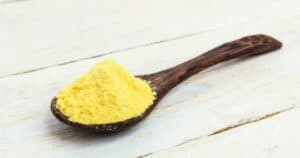Are you tired of using the same old spices to flavor your dishes? Look no further than sage! This versatile herb is not only delicious but also offers some health benefits.
However, many people must learn how to properly grow and prepare sage.
This post will cover everything you need to know about this fantastic herb, including its history, flavor profile, health benefits, growth requirements, and popular dishes that use sage.
Get ready to elevate your culinary game with sage!
Sage (Salvia officinalis) is a woody perennial shrub native to the Mediterranean region. This aromatic herb has grayish leaves and blue to purplish flowers and is a popular ingredient in many dishes, such as stuffing and sausages.
The slightly bitter and earthy flavor of sage pairs well with other herbs like rosemary and thyme. Did you know that sage also has potential health benefits, such as improving brain function and reducing inflammation.
By the end of this post, you’ll have all the sage advice you need to add this herb to your repertoire.
The History of Sage: How This Herb Became a Staple in Mediterranean Cuisine
Sage is a herb native to Southern Europe and the Eastern Mediterranean. Its history is long and rich, with both medicinal and culinary uses.
The Romans first used sage medicinally to aid the digestion of fatty foods. The herb then became a staple in Mediterranean cuisine, still widely used today.
In addition to its use in food, sage has been used for centuries for its medicinal properties. It is believed to have many health benefits, such as improving cognitive function and relieving inflammation.
Sage has a long history in French cuisine as well. At one point, the French produced bountiful crops of sage, using it in dishes like bouillabaisse and ratatouille.
Today, sage is commonly used as a seasoning in various containers, such as soups, stews, casseroles, and meat.
Sage’s Flavor Profile: The Perfect Herb to Elevate Your Cooking Game
Sage is the perfect herb to elevate your cooking game! Its unique flavor profile is earthen, slightly bitter, and has a hint of sweetness.
Rich and oily foods, such as butternut squash soup, pair well with sage, making it a great addition to many dishes. When buying sage, choose green leaves that are fragrant, either fresh or dried.
Chefs love experimenting with sage’s taste and testing it with different foods. Sage adds a mouthwatering depth to your dishes and is very versatile.
You can use sage as a main ingredient or enhance other herbs’ flavor. Remember not to overuse sage in your plate; it’s better to add a little at a time and build up to the preferred taste.
If you happen to go overboard, dilute the flavor by adding more of the dish without sage and mix.
Sage is also known for its health benefits; it contains antioxidants and anti-inflammatory compounds to help the body fight infections and diseases.
Sage can also improve digestion and reduce inflammation in the body. You can easily incorporate sage into your diet by seasoning meats, vegetables, and soups to enhance the flavor while helping your body stay healthy.
So, not only is sage delicious, but it’s also good for you!
The Health Benefits of Sage: Boosting Brain Function and Reducing Inflammation
Sage is a wonder herb known for its health benefits, including enhancing brain function and reducing inflammation.
Sage plants have powerful antioxidant properties, boosting memory and cognitive performance and promoting a healthy inflammatory response.
Sage leaves are also known for their immune-boosting properties that can help protect against infections. Drinking sage tea regularly can help raise antioxidant defenses and lower LDL cholesterol levels, promoting oral health.
Research suggests that sage has many health benefits. Here are some ways in which sage can boost brain function and reduce inflammation:
- Sage contains compounds that can protect the brain from oxidative stress and improve cognitive performance. These compounds can also enhance memory and have been shown to help prevent cognitive decline in older adults.
- Sage has anti-inflammatory properties that may help combat chronic diseases such as arthritis, heart disease, and cancer. The antioxidants in sage can prevent damage to cells and tissues caused by inflammation.
- Drinking sage tea can also help reduce anxiety and improve mood. Sage contains compounds that may have a calming effect and promote relaxation.
Cooking With Sage: Tips and Tricks for Using This Versatile Herb in Your Kitchen
Sage is a versatile herb that adds flavor to your meals. Add it early in your cooking process to get the most out of it. If you want a subtle taste, add it at the beginning.
But if you want to taste it, add it towards the end. Sage pairs particularly well with chicken, pork, beans, risotto, and soups. And if you’re feeling adventurous, try frying sage to give it a milder flavor.
You can also use sage with other seasonings like garlic or onion to make your dishes even more flavorful.
Another excellent use for sage is making sage vinegar. This will help preserve the flavor of sage so you can use it for various dishes. Just add sage to vinegar and let it sit for a few days.
After that, you can use the infused vinegar to
When using sage in your cooking, there are a few other tips and tricks to keep in mind. For example, chop it up finely to get the most flavor.
Also, try using fresh sage instead of dried sage whenever possible, as it has a more potent flavor. And if you’re looking for a new way to use sage, try making sage butter.
All you need to do is mix some finely chopped sage with softened butter and spread it on your bread or use it for cooking your meals.
Culinary Pairings: Sage Goes Well With These Other Herbs and Flavors
Sage is a powerful herb with a distinct taste that complements other flavors perfectly. It’s earthy and slightly peppery with hints of mint, eucalyptus, and lemon.
Sage pairs well with other herbs like thyme, marjoram, and rosemary. It also harmonizes with garlic, onion, oregano, parsley, and bay leaf.
Combining sage with different flavors creates an appealing overall taste profile that can enhance any dish.
Regarding culinary pairings, sage goes exceptionally well with fatty meats like chicken and goose and oily fish like salmon and trout. It’s also a fantastic addition to pasta dishes such as ravioli or gnocchi and is a perfect potato seasoning.
Sage brings a unique fragrance to the table that can complement various ingredients.
Sage pairs particularly well with soft cheeses like brie, feta, fontina, gruyere, parmesan, and ricotta. Combining the bold and fragrant sage with the creamy texture of the cheese can be an unforgettable taste experience.
Sage can also be used as a seasoning for soups and stews, bringing a warm and comforting flavor to various dishes.
Sage Substitute
Are you looking for a Sage Substitute? Marjoram, rosemary, thyme, oregano, savory, tarragon, and basil have similar flavor profiles and can be used as much as sage in most recipes.





